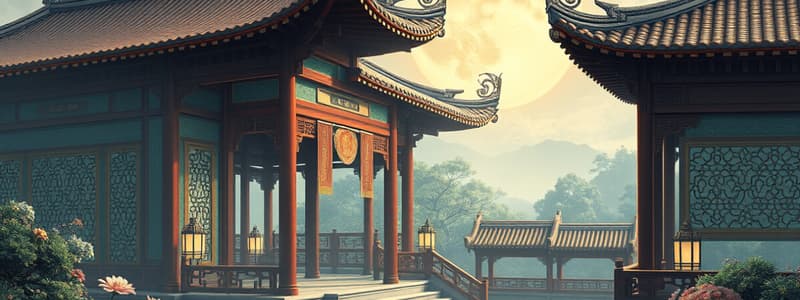Podcast
Questions and Answers
What were some causes of the Self-Strengthening Movement?
What were some causes of the Self-Strengthening Movement?
- Internal rebellion (correct)
- External invasion (correct)
- Political stability
- Economic prosperity
What was the duration of the Self-Strengthening Movement?
What was the duration of the Self-Strengthening Movement?
1860-1894
What principles did the Self-Strengthening Movement advocate?
What principles did the Self-Strengthening Movement advocate?
- Chinese learning for fundamentals (correct)
- Western ideas only
- Complete isolation from foreign influences
- Complete westernization
What was the aim of the Self-Strengthening Movement?
What was the aim of the Self-Strengthening Movement?
Who were some of the leaders of the Self-Strengthening Movement?
Who were some of the leaders of the Self-Strengthening Movement?
When was the Jiangnan Arsenal established?
When was the Jiangnan Arsenal established?
How many steamships did the Fuzhou Arsenal build?
How many steamships did the Fuzhou Arsenal build?
What year was the Tianjin Naval Academy established?
What year was the Tianjin Naval Academy established?
What year was the first phase of the Self-Strengthening Movement?
What year was the first phase of the Self-Strengthening Movement?
Who were the key leaders of the second phase of the Self-Strengthening Movement?
Who were the key leaders of the second phase of the Self-Strengthening Movement?
What were the main features of the third phase of the Self-Strengthening Movement?
What were the main features of the third phase of the Self-Strengthening Movement?
In what year did Prince Gong order Horatio Lay to purchase and equip a steam fleet for China?
In what year did Prince Gong order Horatio Lay to purchase and equip a steam fleet for China?
When was the Interpreters College opened?
When was the Interpreters College opened?
Flashcards are hidden until you start studying
Study Notes
Causes of the Self-Strengthening Movement
- External invasion due to Western penetration, marked by defeats in the Opium Wars, prompted military reforms and adoption of Western knowledge.
- Internal challenges included the Taiping Rebellion, a destructive civil war threatening Qing Dynasty stability.
- The Tongzhi Restoration aimed to restore Qing authority following the death of Xianfeng Emperor in 1861, initiating reforms that lasted until the 1890s.
Duration of the Movement
- The Self-Strengthening Movement spanned from 1860 to 1894.
Principles of the Movement
- Advocated for a foundation in Confucian ethics while incorporating Western science and technology.
- Emphasized a selective approach: "Chinese learning for the fundamental, Western learning for practical use."
Aims of the Movement
- Intended to modernize China's military for protection against internal rebellions and foreign invasions.
- Aimed to bolster support for the Qing dynasty amid growing challenges.
Key Leaders of the Movement
- Zeng Guofan: Organized local armies against the Taiping rebellion, established Jiangnan Arsenal, and promoted foreign language education and modernization efforts.
- Zeng Zuotang: Gained prominence during the Taiping Rebellion; founded the Fuzhou Arsenal to support naval affairs.
- Li Hongzhang: Influential statesman who negotiated significant treaties; established multiple arsenals, the Beiyang Fleet, and promoted industrial advancements including a steam navigation company.
Significant Institutions
- Jiangnan Arsenal (1865): Manufactured military equipment and served as a translation bureau for Western literature, completing its first ship in 1868.
- Fuzhou Arsenal (1866): Created 40 steamships as part of naval modernization efforts.
- Nanjing Arsenal (1867): Contributed to the military-industrial complex.
- Tianjin Naval Academy (1880): Provided naval training amidst an evolving military landscape.
- Tianjin Military Academy (1885): Sent students abroad for military training, particularly in Britain and Germany.
Naval Developments
- Beiyang Fleet (1888): Established with internal corruption undermining naval strength, particularly influenced by Cixi.
- China's Merchants' Steam Navigation Company (1872): Focused on improving maritime trade and shipping.
Phases of the Movement
- First Phase (1861-1872): Marked by strong military emphasis and introduction of Western weaponry; key leaders included Prince Gong and Zeng Guofan.
- Second Phase (1872-1885): Concentrated on economic development, involving private and government-sponsored enterprises; led primarily by Li Hongzhang.
- Third Phase (1885-1895): Shifted focus to light industry; introduced joint and private enterprises with leaders including Li Hongzhang, Zhang Zhidong, and Liu Kunyi.
Key Military Forces
- Ever Victorious Army: Comprised mainly of Westerners; played a crucial role during the Taiping Rebellions.
Educational Reforms
- Establishment of Interpreters College (1862): The first foreign language school in Peking, part of broader educational reforms aimed at improving foreign relations and military readiness.
- Purchase of Steam Fleet: Ordered in 1862 by Prince Gong, marking a significant step in naval modernization and enhancement of military capabilities.
Studying That Suits You
Use AI to generate personalized quizzes and flashcards to suit your learning preferences.



